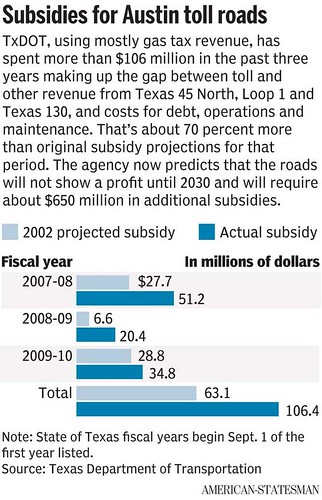For whom the price tolls
Of course, from the standpoint of economically sound decisions, tolls on roads make sense. And hard core conservatives like the idea of toll roads, especially privately constructed "HOT" (high occupancy toll) lanes. See "What's HOT?: HOT lanes, coming soon" from the Fredericksburg Freelance-Star.
From the article:
Under the current funding plan, almost 100 percent of the cost of Phase 2 of the Dulles Metrorail project is to be paid from local sources: one-fourth from Fairfax and Loudoun counties and the airports authority, and three-fourths from Dulles Toll Road revenue. There is no state grant assistance. There is no federal grant assistance.
No other transit megaproject in the United States is 100 percent locally funded. In fact, most have combined state and federal assistance of at least one-third of costs.
It should hardly be a shock, then, that the tolls needed to support Dulles Metrorail will be eye-popping. To be sure, the secretary’s process, by reducing Phase 2 costs (and shifting $400 million of costs to Fairfax and Loudoun), will have some mitigating effect on tolls. But even at the $2.8 billion cost the secretary has found acceptable, today’s $2 toll is projected to be $13 in 20 years, $17 in 30 years.
Texas

Tolls and other revenue have fallen more than $100 million short of covering debt and operating costs of the state's three-road Central Texas Turnpike System since the highways opened about four years ago. Texas Department of Transportation subsidies almost 70 percent more than originally predicted have made up the difference.
Those subsidies, covered primarily by state gasoline taxes that otherwise would be available for other road spending, should average about $38 million a year over the next decade and total about $750 million by 2042 , according to TxDOT documents. The system's first profitable year is not estimated to occur until 2030 , with some years in the red even after that because of major road rehabilitation expenses.
California
The Los Angeles Times reports in "San Diego County regional government to buy bankrupt toll road" about how the local government in San Diego County is buying a toll road because it's not able to pay its way. From the article:
Instead it became a cautionary tale about risky assumptions, and the stubborn opposition of motorists to paying tolls. In March 2010 the road's operator filed for Chapter 11 bankruptcy protection, noting that traffic counts were less than 50% of projections.
Labels: tolls, transportation planning



0 Comments:
Post a Comment
<< Home